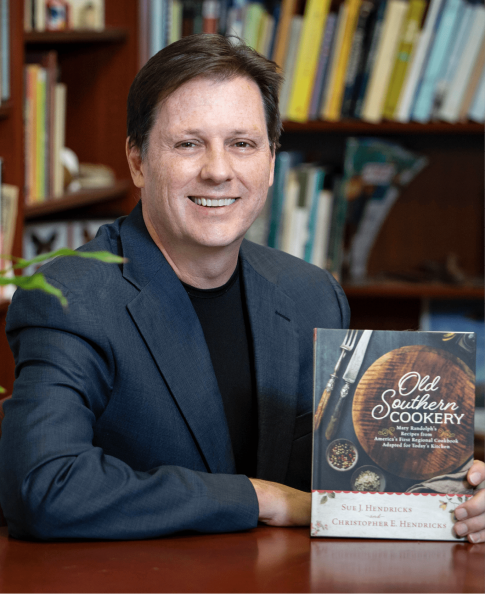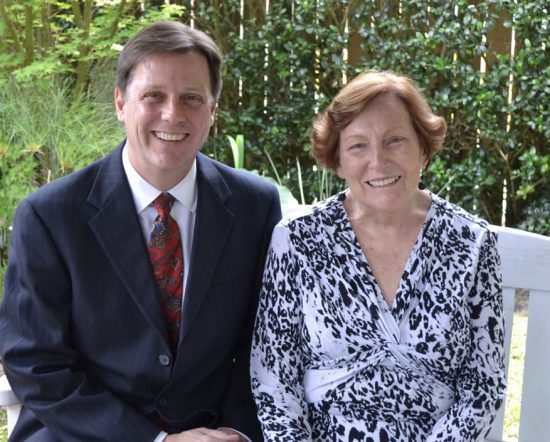Cooking Through History
Georgia Southern History Professor and his Mother Recreate Southern Recipes from 1824

Old Southern Cookery: Mary Randolph’s Recipes from America’s First Regional Cookbook Adapted for Today’s Kitchen is much more than an ordinary cookbook.
Written by Georgia Southern history professor Christopher Hendricks, Ph.D. and his mother, retired journalist Sue Hendricks, the book is a living history of food in America, and the people who prepared it.
The Gift
The project began as a gift in the 1970s. The late historian and Sue Hendrick’s husband, J. Edwin Hendricks, returned from a research trip to Philadelphia and brought his wife an old cookbook, The Virginia Housewife, written by Mary Randolph and originally published in 1824.
“My husband brought me this cookbook and suggested that I try all the recipes, substituting modern measurements and instructions, and then we could have it printed.” said Sue Hendricks. “So, that’s how it started.”
“That was in the ‘70s when I was a kid,” said Chris Hendricks. “And so while Mother was going through these recipes and translating them for contemporary cooks, we didn’t know at the time what was going on. It was just what we were having for dinner.”
Sue was able to translate the old ingredients and cooking instructions into modern terminology as she prepared the dishes for family meals and dinner parties. Some of the original instructions were things like “take butter to the size of an egg” and “when the fire be ready to go…” which makes no sense to the modern cook.
“The only thing that flustered me was the size of an egg,” she said. “Almost every recipe would have butter, lard and whatever the size of an egg. So I did some experimenting with egg sizes and came up with a quarter of a cup being the closest to the average egg. They cooked with open fires, so I went with a 350-degree oven for most baked things.”
As Sue worked her way through and adapted the old recipes, several became family favorites. Cabbage a la crème was transformed into a grilled foil package for barbecues, Randolf’s trifle and mincemeat pie were often seen at Christmas.
Creating a Cookbook

The Hendricks’ had lined up a publisher for the manuscript, but the company went bankrupt and the translated recipes lay dormant for more than 20 years. Then, when Chris was helping his parents move about six years ago, he found the original typed manuscript in a box in the attic. Preparing to take a semester research leave, he decided to research the background of Mary Randolph, the legacy of her cookbook and other historical details.
“A lot of culinary historians will place Mary Randolph’s book as being the first genuine American cookbook,” said Chris.
He wrote an introduction and assembled about 100 of his mother’s revised recipes and Mary Randolph’s versions together with a historical explanation of each recipe, ingredients, even the kitchen utensils used in the 19th century.
“So that is what I gave mother for Christmas,” said Chris. “After that we started looking around for a publisher. It was going to be a historical document, the best footnoted and peer-reviewed cookbook anyone had ever owned.”
Supporting Savannah’s History
Chris had been working with the Davenport House in Savannah for almost 30 years, so he approached them about using the new cookbook as a fundraising project. They jumped at the chance and got involved in the entire publication process including hiring a book agent. After receiving interest from several academic presses, they accepted an offer from a popular press, Globe Pequot.
“They paid an advance,” said Chris. “How many academic books get advances? It’s crazy! So that meant that we were able to hire some professional food photographers.”
The resulting cookbook is filled with gorgeous food photos plated on the Davenport House’s china collection from the 1820s, the same era as The Virginia Housewife. The cookbook includes chapters on soups, meats, seafood, poultry, vegetables and desserts.
Cooking and Quarantine
It’s an amazing cookbook that goes well with the current cooking frenzy of quarantining and is proving a valuable fundraiser for the Davenport House, even though the book launch events were all cancelled due to COVID-19.
“Food is comforting,” said Sue. “I think cooking soothes the world. If you start cooking, you can create something and you can see it succeed. It wipes away some of the tension of things that you can’t control. I am just really pleased that Chris pushed me on the book and that it’s selling and that people can learn fun things about history through food”.
“This has been essentially a series of presents,” said Chris. “It started as a present from my father to my mother. Then I took it and ran with it and did the manuscript as a present to my mother. And now, Mother and I are giving the proceeds as a present to the historic community. It’s so special and different from any project I’ve ever worked on before in my career.” — Liz Walker
